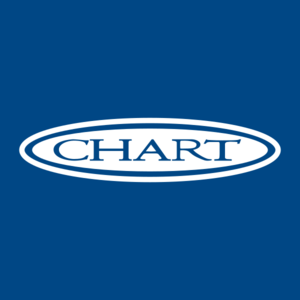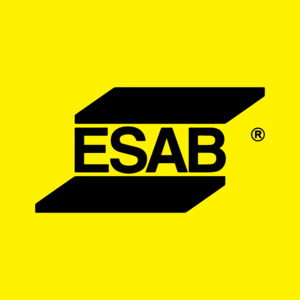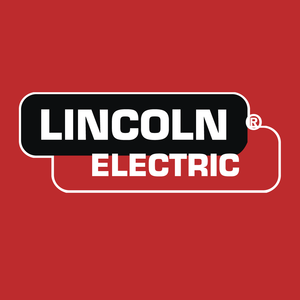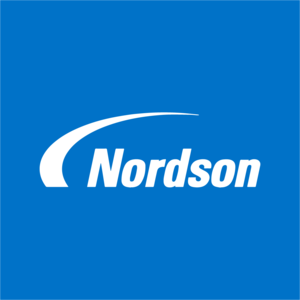
Nordson (NDSN)
We’re skeptical of Nordson. Its weak sales growth and declining returns on capital show its demand and profits are shrinking.― StockStory Analyst Team
1. News
2. Summary
Why We Think Nordson Will Underperform
Founded in 1954, Nordson Corporation (NASDAQ:NDSN) manufactures dispensing equipment and industrial adhesives, sealants and coatings.
- Core business is underperforming as its organic revenue has disappointed over the past two years, suggesting it might need acquisitions to stimulate growth
- Anticipated sales growth of 3.8% for the next year implies demand will be shaky
- A bright spot is that its offerings are difficult to replicate at scale and result in a best-in-class gross margin of 55%


Nordson fails to meet our quality criteria. There are better opportunities in the market.
Why There Are Better Opportunities Than Nordson
High Quality
Investable
Underperform
Why There Are Better Opportunities Than Nordson
At $238.79 per share, Nordson trades at 21.8x forward P/E. Nordson’s multiple may seem like a great deal among industrials peers, but we think there are valid reasons why it’s this cheap.
We’d rather pay up for companies with elite fundamentals than get a bargain on weak ones. Cheap stocks can be value traps, and as their performance deteriorates, they will stay cheap or get even cheaper.
3. Nordson (NDSN) Research Report: Q2 CY2025 Update
Manufacturing company Nordson (NASDAQ:NDSN) beat Wall Street’s revenue expectations in Q2 CY2025, with sales up 12.1% year on year to $741.5 million. Its non-GAAP profit of $2.73 per share was 3.5% above analysts’ consensus estimates.
Nordson (NDSN) Q2 CY2025 Highlights:
- Revenue: $741.5 million vs analyst estimates of $722.2 million (12.1% year-on-year growth, 2.7% beat)
- Adjusted EPS: $2.73 vs analyst estimates of $2.64 (3.5% beat)
- Adjusted EBITDA: $238.5 million vs analyst estimates of $230.1 million (32.2% margin, 3.7% beat)
- Operating Margin: 25.3%, in line with the same quarter last year
- Free Cash Flow Margin: 30.5%, up from 21.6% in the same quarter last year
- Organic Revenue rose 2.1% year on year vs analyst estimates of flat growth (144.6 basis point beat)
- Market Capitalization: $12.29 billion
Company Overview
Founded in 1954, Nordson Corporation (NASDAQ:NDSN) manufactures dispensing equipment and industrial adhesives, sealants and coatings.
Nordson Corporation was established by brothers Eric and Evan Nord, evolving from the U.S. Automatic Company, which began in 1909. Initially focusing on screw machine parts for the automotive industry, the company shifted to producing high-precision parts during World War II. Post-war, the brothers sought a proprietary product, finding it in the "hot airless" method of spraying paint, leading to the creation of Nordson as a division of U.S. Automatic Corporation.
In 1966, U.S. Automatic merged into Nordson Corporation, continuing its development of spray painting and powder coating technologies. In 1986, Nordson acquired companies such as Industriell Coating Aktiebolag and Meltex, enhancing its adhesive dispensing capabilities. The company expanded into high technology and electronics industries in the late 1990s, acquiring firms such as Asymtek and EFD, which are integral to Nordson’s Advanced Technology segment today. In the 2010s, Nordson strengthened its position in precision technology and entered the medical, test and inspection, and polymer processing areas through acquisitions, including Micromedics and Value Plastics.
Today, Nordson Corporation produces a variety of advanced products and systems that serve diverse industries. Its offerings range from precision dispensing equipment and coating systems for the electronics and packaging sectors to medical devices such as catheters and medical tubing for the healthcare industry. The company generates revenue from the sale of these products, as well as from contracts for related software, maintenance services, and aftermarket parts, which generate a source of recurring revenue.
The company continues an acquisition strategy of selectively focusing on companies that offer strong operational value and enhance its product. For instance, in August 2023, Nordson acquired the ARAG Group, a leader in precision control systems and smart fluid components for agricultural spraying. This strategic acquisition aligns with Nordson’s objective to enhance its offerings in precision technology and expand its presence in the growing agriculture market.
4. Professional Tools and Equipment
Automation that increases efficiency and connected equipment that collects analyzable data have been trending, creating new demand. Some professional tools and equipment companies also provide software to accompany measurement or automated machinery, adding a stream of recurring revenues to their businesses. On the other hand, professional tools and equipment companies are at the whim of economic cycles. Consumer spending and interest rates, for example, can greatly impact the industrial production that drives demand for these companies’ offerings.
Competitors offering similar products include Graco (NYSE:GGG), Illinois Tool Works (NYSE:ITW), and Sono-Tek (OTCMKTS: SOTK).
5. Revenue Growth
Reviewing a company’s long-term sales performance reveals insights into its quality. Any business can experience short-term success, but top-performing ones enjoy sustained growth for years. Over the last five years, Nordson grew its sales at a tepid 5.3% compounded annual growth rate. This was below our standard for the industrials sector and is a tough starting point for our analysis.
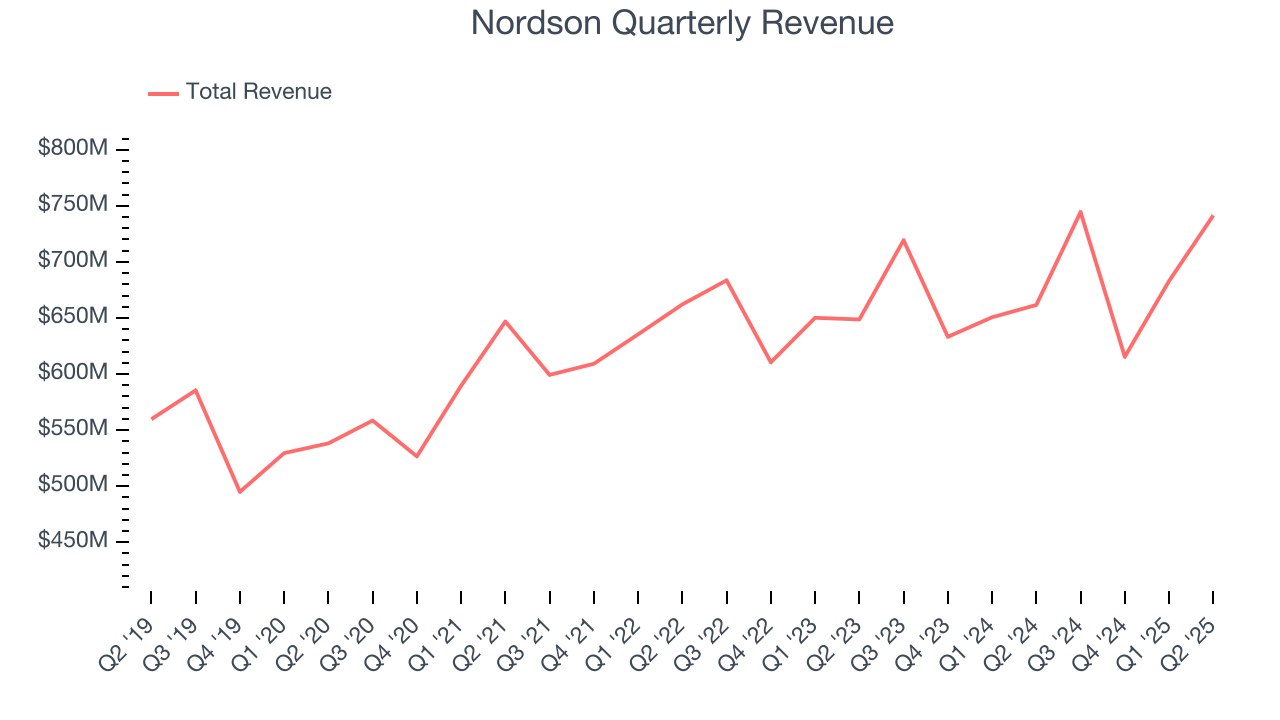
We at StockStory place the most emphasis on long-term growth, but within industrials, a half-decade historical view may miss cycles, industry trends, or a company capitalizing on catalysts such as a new contract win or a successful product line. Nordson’s recent performance shows its demand has slowed as its annualized revenue growth of 3.6% over the last two years was below its five-year trend. 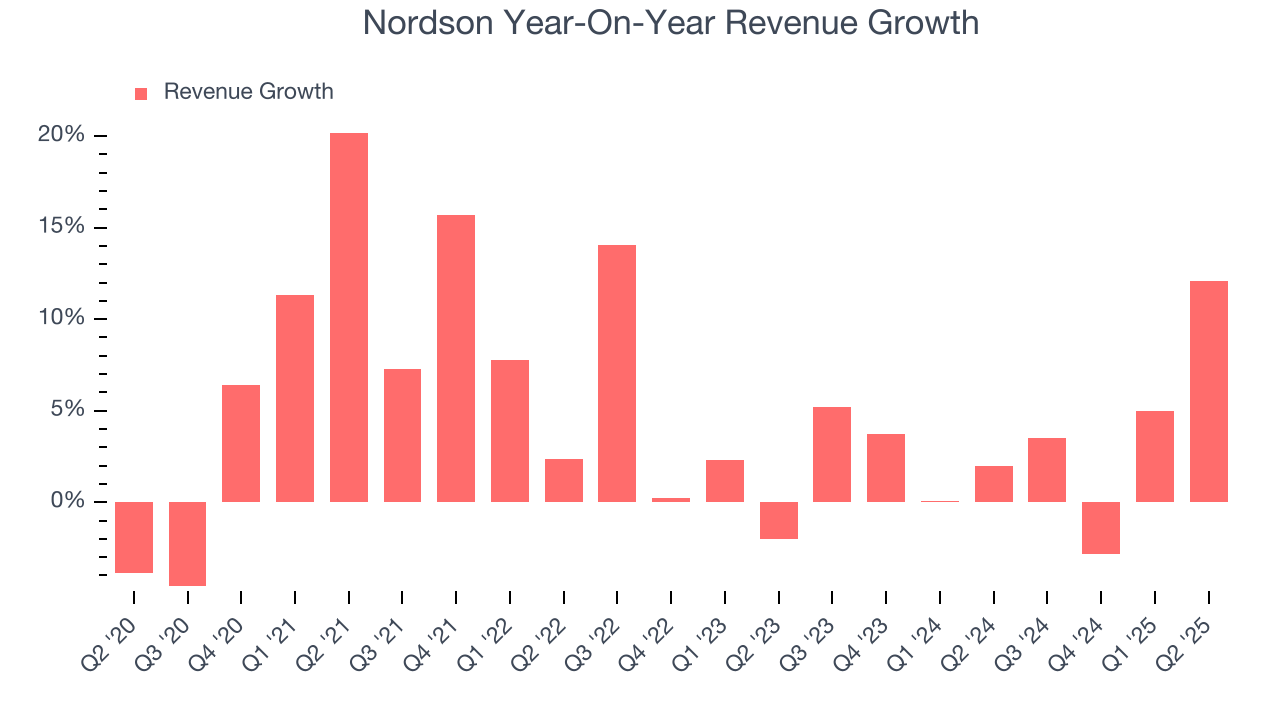
We can dig further into the company’s sales dynamics by analyzing its organic revenue, which strips out one-time events like acquisitions and currency fluctuations that don’t accurately reflect its fundamentals. Over the last two years, Nordson’s organic revenue averaged 2.8% year-on-year declines. Because this number is lower than its two-year revenue growth, we can see that some mixture of acquisitions and foreign exchange rates boosted its headline results. 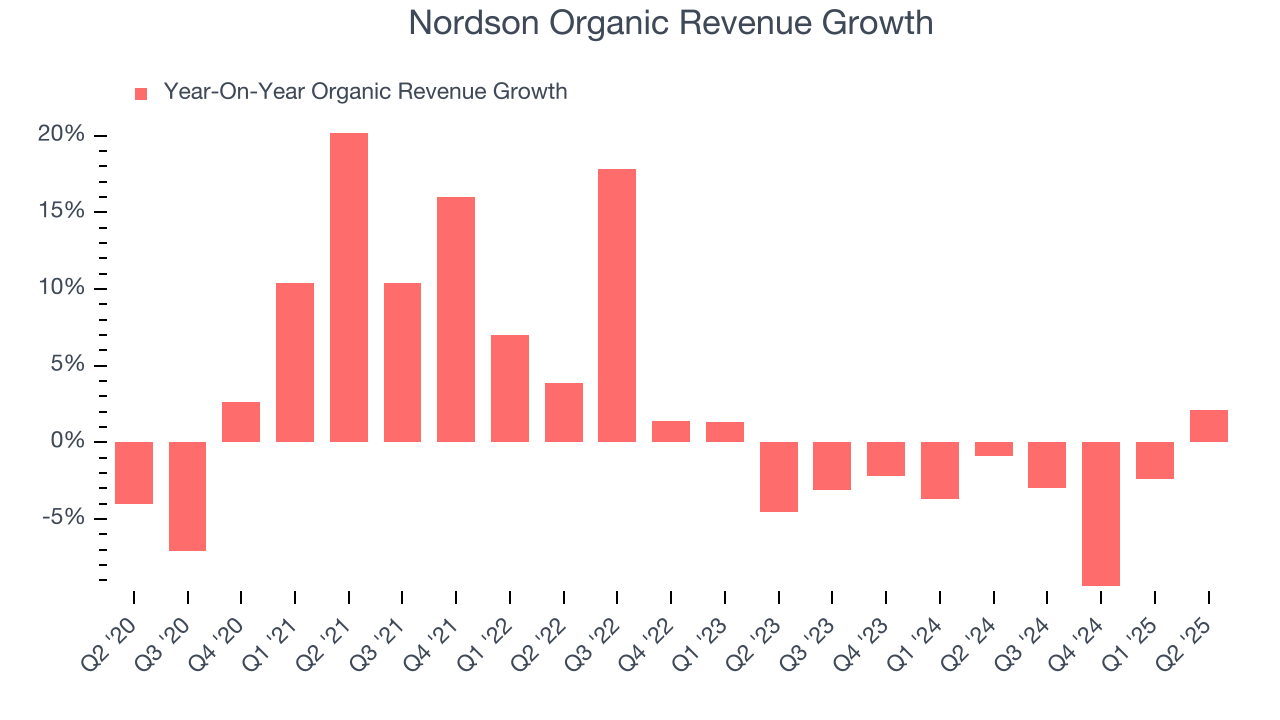
This quarter, Nordson reported year-on-year revenue growth of 12.1%, and its $741.5 million of revenue exceeded Wall Street’s estimates by 2.7%.
Looking ahead, sell-side analysts expect revenue to grow 4.4% over the next 12 months, similar to its two-year rate. This projection doesn't excite us and suggests its newer products and services will not lead to better top-line performance yet.
6. Gross Margin & Pricing Power
Nordson has best-in-class unit economics for an industrials company, enabling it to invest in areas such as research and development. Its margin also signals it sells differentiated products, not commodities. As you can see below, it averaged an elite 55% gross margin over the last five years. That means Nordson only paid its suppliers $45.02 for every $100 in revenue. 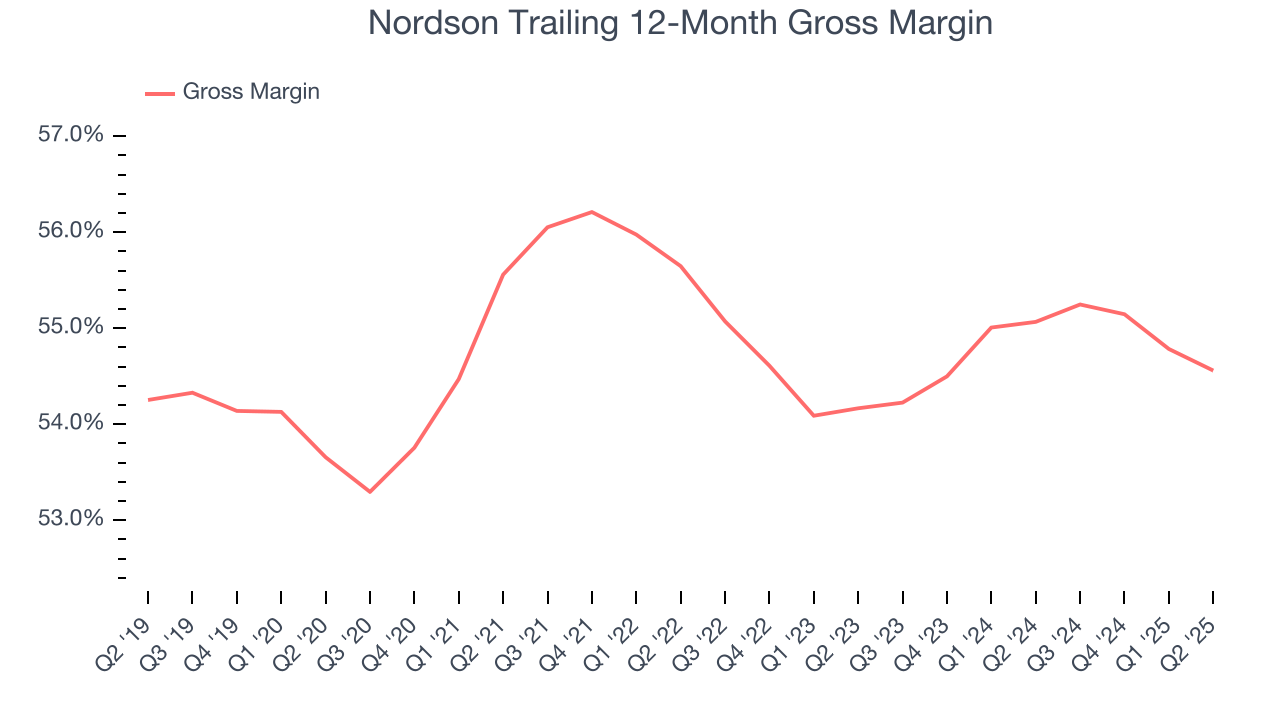
Nordson produced a 54.8% gross profit margin in Q2, in line with the same quarter last year. Zooming out, the company’s full-year margin has remained steady over the past 12 months, suggesting its input costs (such as raw materials and manufacturing expenses) have been stable and it isn’t under pressure to lower prices.
7. Operating Margin
Operating margin is an important measure of profitability as it shows the portion of revenue left after accounting for all core expenses – everything from the cost of goods sold to advertising and wages. It’s also useful for comparing profitability across companies with different levels of debt and tax rates because it excludes interest and taxes.
Nordson has been a well-oiled machine over the last five years. It demonstrated elite profitability for an industrials business, boasting an average operating margin of 24.9%. This result isn’t surprising as its high gross margin gives it a favorable starting point.
Analyzing the trend in its profitability, Nordson’s operating margin rose by 2.7 percentage points over the last five years, as its sales growth gave it operating leverage.
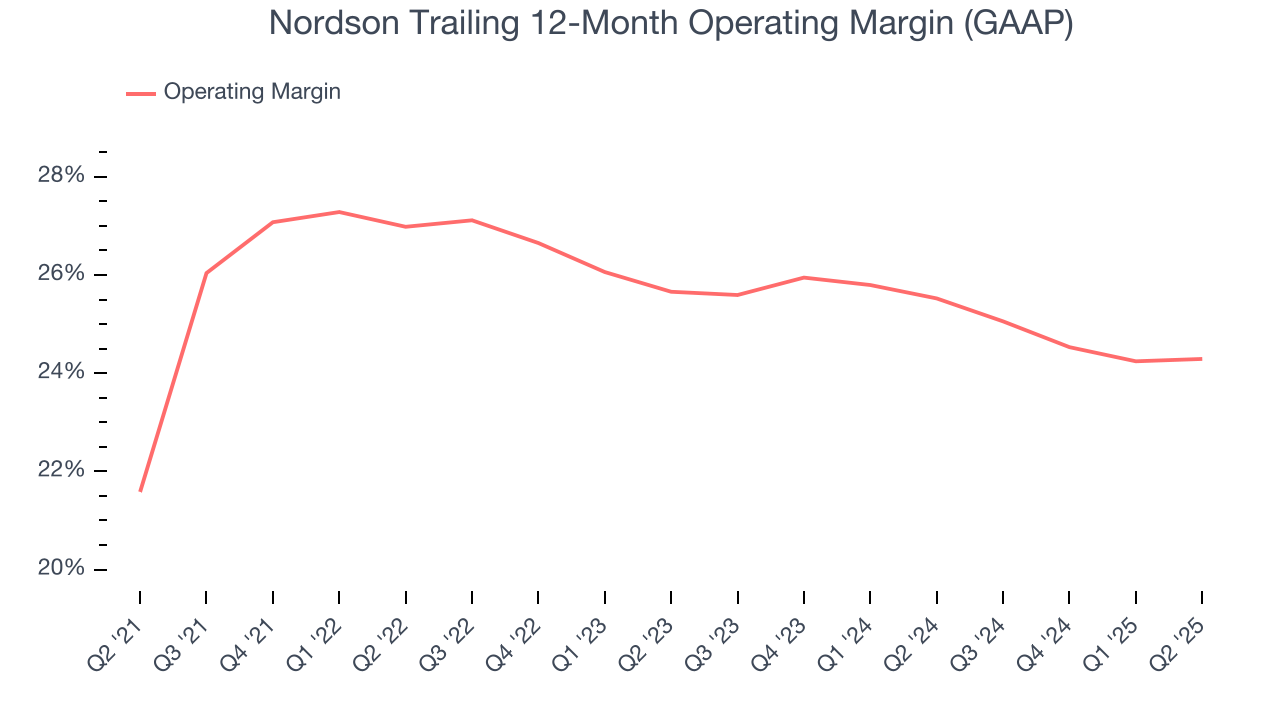
In Q2, Nordson generated an operating margin profit margin of 25.3%, in line with the same quarter last year. This indicates the company’s cost structure has recently been stable.
8. Earnings Per Share
We track the long-term change in earnings per share (EPS) for the same reason as long-term revenue growth. Compared to revenue, however, EPS highlights whether a company’s growth is profitable.
Nordson’s EPS grew at a solid 10.9% compounded annual growth rate over the last five years, higher than its 5.3% annualized revenue growth. This tells us the company became more profitable on a per-share basis as it expanded.
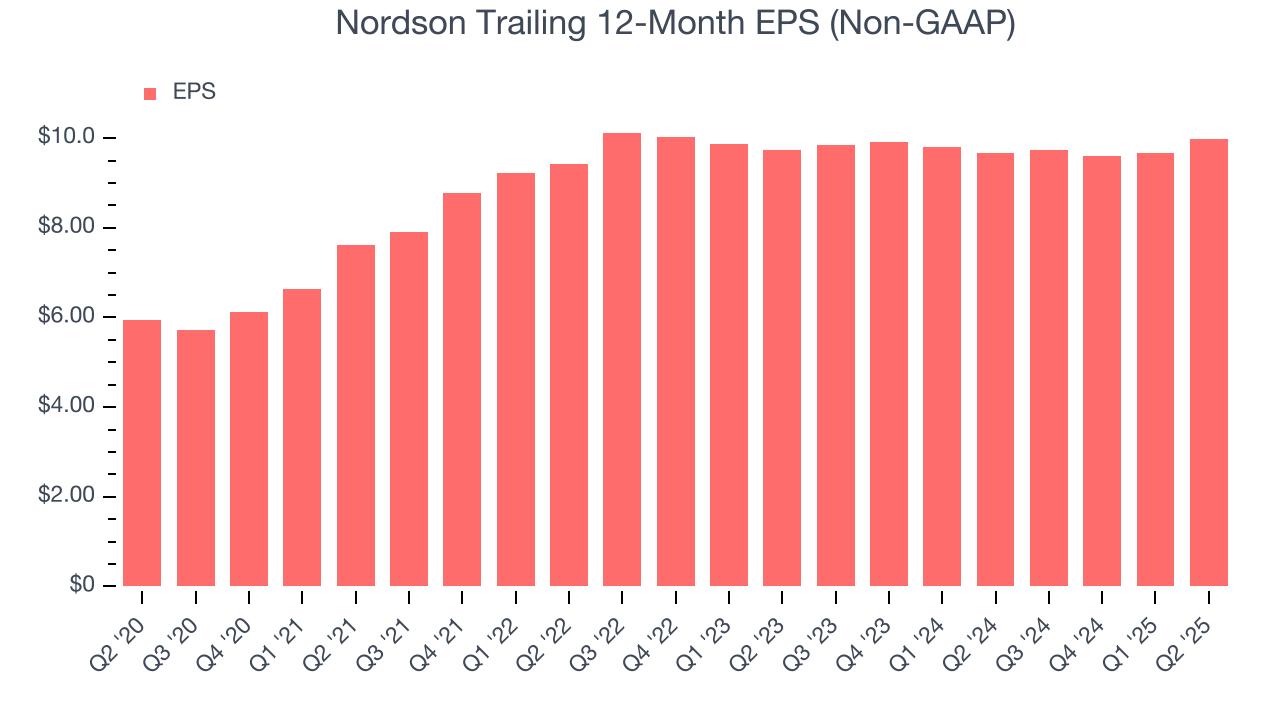
Diving into the nuances of Nordson’s earnings can give us a better understanding of its performance. As we mentioned earlier, Nordson’s operating margin was flat this quarter but expanded by 2.7 percentage points over the last five years. On top of that, its share count shrank by 2.9%. These are positive signs for shareholders because improving profitability and share buybacks turbocharge EPS growth relative to revenue growth. 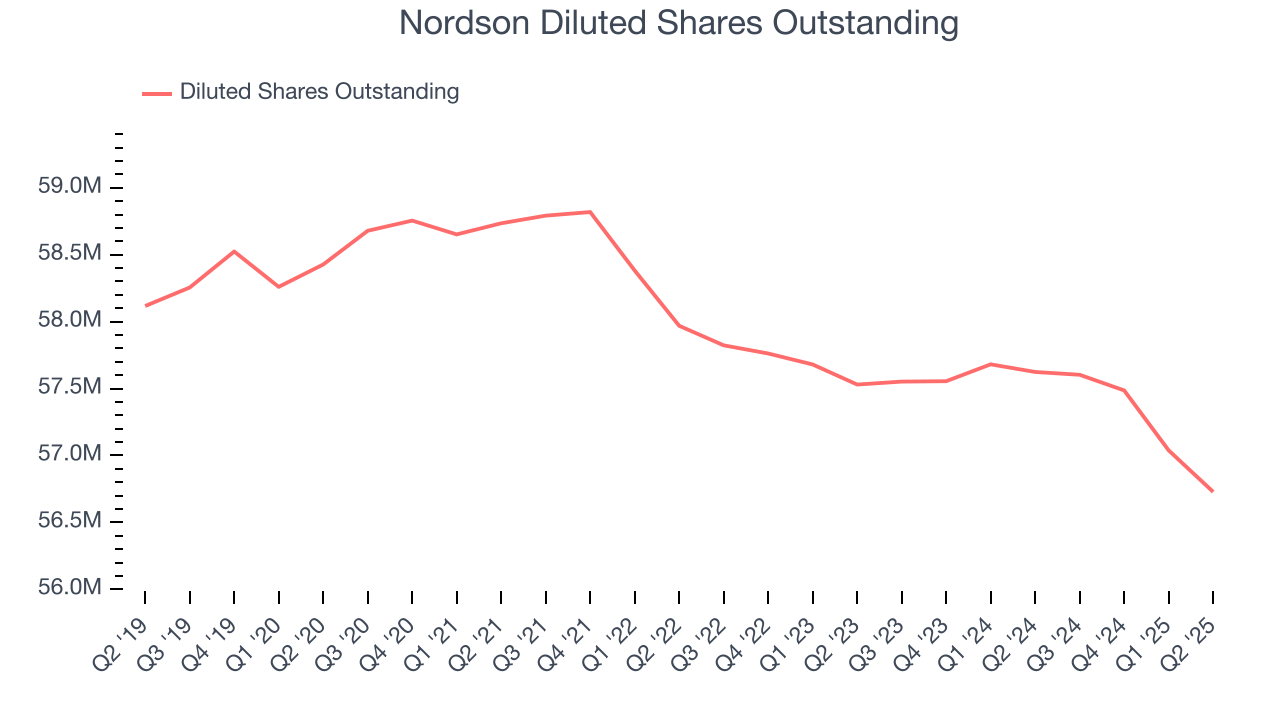
Like with revenue, we analyze EPS over a shorter period to see if we are missing a change in the business.
For Nordson, its two-year annual EPS growth of 1.2% was lower than its five-year trend. We hope its growth can accelerate in the future.
In Q2, Nordson reported adjusted EPS of $2.73, up from $2.41 in the same quarter last year. This print beat analysts’ estimates by 3.5%. Over the next 12 months, Wall Street expects Nordson’s full-year EPS of $9.99 to grow 8.1%.
9. Cash Is King
Free cash flow isn't a prominently featured metric in company financials and earnings releases, but we think it's telling because it accounts for all operating and capital expenses, making it tough to manipulate. Cash is king.
Nordson has shown terrific cash profitability, putting it in an advantageous position to invest in new products, return capital to investors, and consolidate the market during industry downturns. The company’s free cash flow margin was among the best in the industrials sector, averaging 21.1% over the last five years.
Taking a step back, we can see that Nordson’s margin dropped by 3.1 percentage points during that time. If its declines continue, it could signal increasing investment needs and capital intensity.
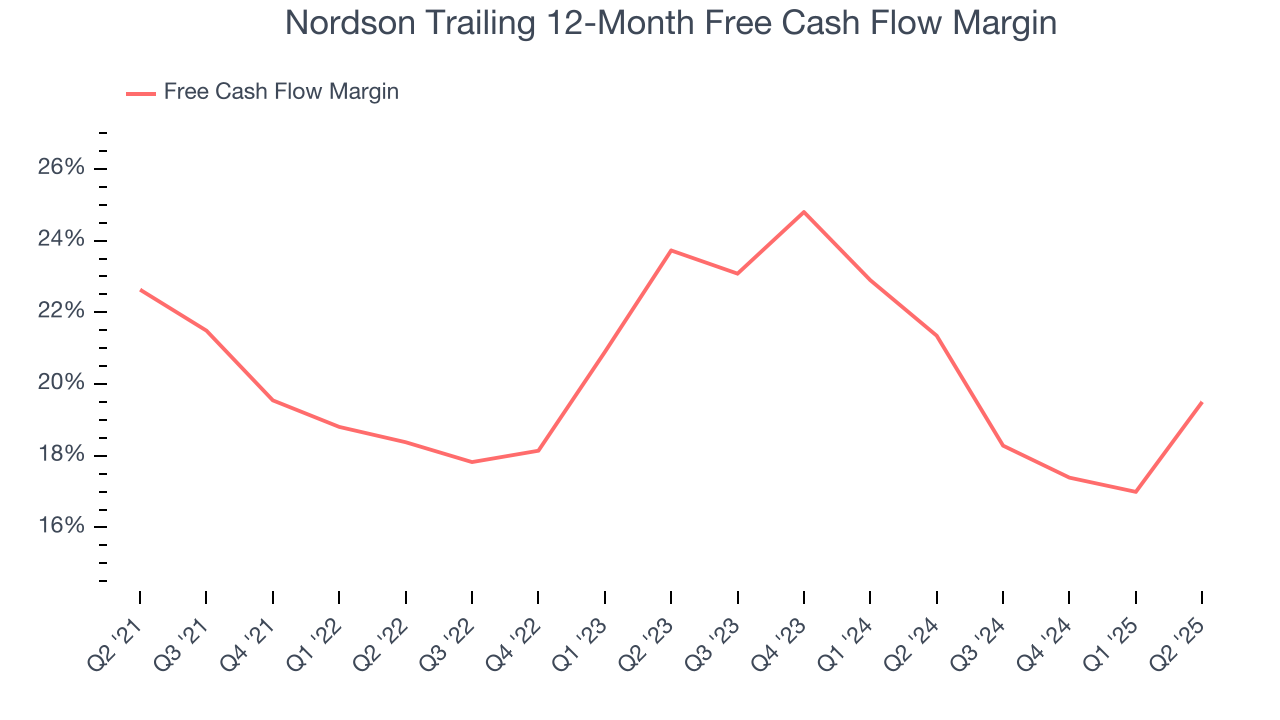
Nordson’s free cash flow clocked in at $226.4 million in Q2, equivalent to a 30.5% margin. This result was good as its margin was 8.9 percentage points higher than in the same quarter last year, but we wouldn’t read too much into the short term because investment needs can be seasonal, causing temporary swings. Long-term trends are more important.
10. Return on Invested Capital (ROIC)
EPS and free cash flow tell us whether a company was profitable while growing its revenue. But was it capital-efficient? A company’s ROIC explains this by showing how much operating profit it makes compared to the money it has raised (debt and equity).
Although Nordson hasn’t been the highest-quality company lately, it historically found a few growth initiatives that worked out well. Its five-year average ROIC was 15.5%, impressive for an industrials business.

We like to invest in businesses with high returns, but the trend in a company’s ROIC is what often surprises the market and moves the stock price. Over the last few years, Nordson’s ROIC has unfortunately decreased. We like what management has done in the past, but its declining returns are perhaps a symptom of fewer profitable growth opportunities.
11. Balance Sheet Assessment
Nordson reported $147.8 million of cash and $2.12 billion of debt on its balance sheet in the most recent quarter. As investors in high-quality companies, we primarily focus on two things: 1) that a company’s debt level isn’t too high and 2) that its interest payments are not excessively burdening the business.
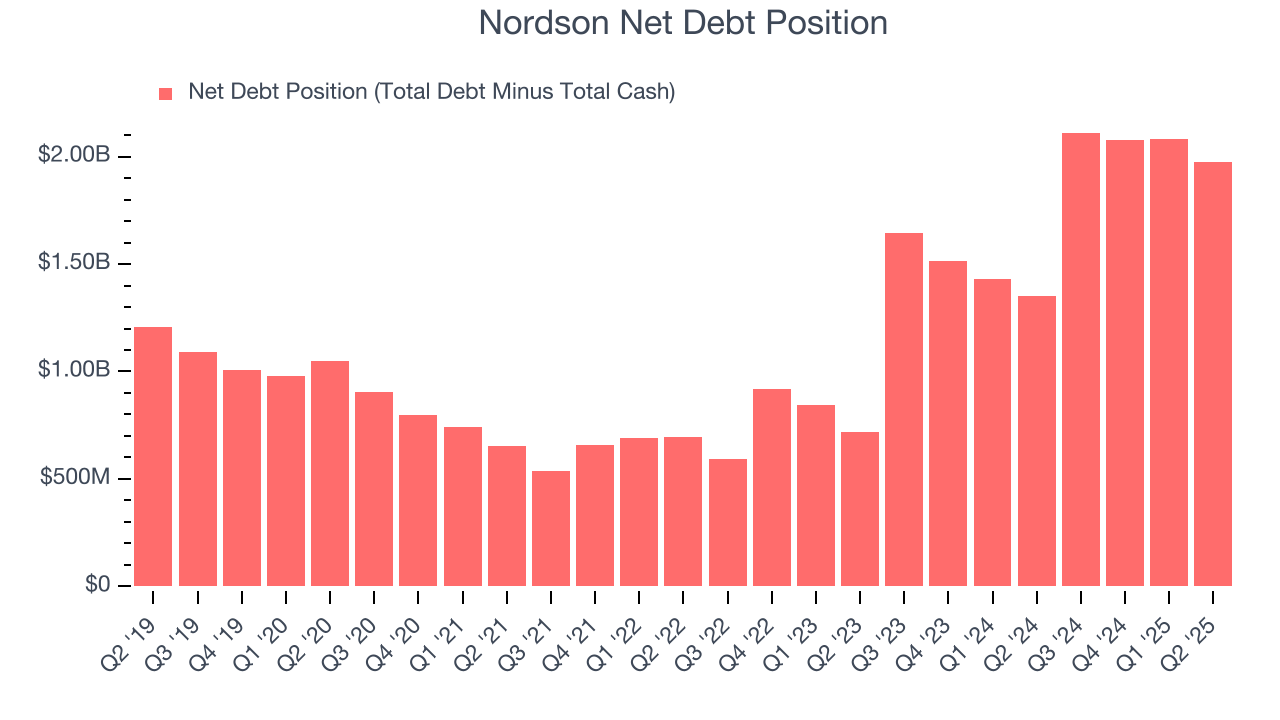
With $884.9 million of EBITDA over the last 12 months, we view Nordson’s 2.2× net-debt-to-EBITDA ratio as safe. We also see its $104.6 million of annual interest expenses as appropriate. The company’s profits give it plenty of breathing room, allowing it to continue investing in growth initiatives.
12. Key Takeaways from Nordson’s Q2 Results
We enjoyed seeing Nordson beat analysts’ revenue expectations this quarter. We were also happy its EBITDA outperformed Wall Street’s estimates. Overall, we think this was a decent quarter with some key metrics above expectations. The stock traded up 2.1% to $218 immediately after reporting.
13. Is Now The Time To Buy Nordson?
Updated: December 5, 2025 at 10:27 PM EST
Before deciding whether to buy Nordson or pass, we urge investors to consider business quality, valuation, and the latest quarterly results.
Nordson isn’t a terrible business, but it doesn’t pass our quality test. To begin with, its revenue growth was uninspiring over the last five years, and analysts expect its demand to deteriorate over the next 12 months. And while its admirable gross margins indicate the mission-critical nature of its offerings, the downside is its diminishing returns show management's prior bets haven't worked out. On top of that, its organic revenue declined.
Nordson’s P/E ratio based on the next 12 months is 21.8x. Beauty is in the eye of the beholder, but we don’t really see a big opportunity at the moment. We're pretty confident there are more exciting stocks to buy at the moment.
Wall Street analysts have a consensus one-year price target of $257.30 on the company (compared to the current share price of $238.79).




